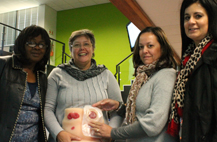Latest News Archive
Please select Category, Year, and then Month to display items
05 June 2018
Photo Supplied
 Archaeological excavations in the Wonderwerk Cave, north of Kuruman in the Northern Cape.
Archaeological excavations in the Wonderwerk Cave, north of Kuruman in the Northern Cape.
Research fellow Dr Lloyd Rossouw from the Department of Plant Sciences at the University of the Free State (UFS) recently published an article in the Nature Ecology and Evolution journal with Dr Michaela Ecker from the University of Toronto as lead author, and Dr James Brink, research fellow at the UFS Centre for Environmental Management. The findings described in “The palaeoecological context of the Oldowan-Acheulean in southern Africa” provides the first extensive paleoenvironmental sequence for the interior of southern Africa by applying a combination of methods for environmental reconstruction at Wonderwerk Cave, which have yielded multiple evidence of early human occupation dating back almost two million years ago.
Where water once was
The Wonderwerk Cave is found north of the Kuruman hills (situated in Northern Cape) a 140m long tube with a low ceiling. The surroundings are harsh. Semi-arid conditions allow for the survival of only hardy bushes, trees, and grasses. But during the Early Pleistocene, stepping out of the Wonderwerk Cave you would have been greeted by a completely different site, the researchers found. Using carbon and oxygen stable isotope analysis on the teeth of herbivores (Dr Ecker), fossil faunal abundance (Dr Brink), as well as the analysis of microscopic plant silica remains (phytoliths) excavated from fossil soils inside the cave (Dr Rossouw), the results show that ancient environments in the central interior of southern Africa were significantly wetter and housed a plant community unlike any other in the modern African savanna.
What difference does it make?
While East African research shows increasing aridity and the spread of summer-rainfall grasslands more than a million years ago, the results from this study indicate an interesting twist. During the same period, shifts in rainfall seasonality allowed for alternating summer and winter-rainfall grass occurrences coupled with prolonged wetlands, that remained major components of Early Pleistocene (more or less the period between one and two million years ago) environments in the central interior of southern Africa. That means our human ancestors were also living and evolving in environments other than the generally accepted open, arid grassland model.
School of Nursing takes the lead in skills development in South Africa
2012-05-22
 |
|
Professional nurses gained hands-on experience in Stoma-Care Nursing at a five-day short-learning programme at the UFS School of Nursing.
Photo: René-Jean van der Berg
22 May 2012
|
The School of Nursing presented the first Stoma Care Nursing short learning programme on the Bloemfontein Campus this week.
Mrs Diane Keegan, Assistant Director for Short Learning Programmes at the UFS School of Nursing, said this was the only programme of its type for professional nurses in South Africa.
“Stoma-care nursing is a sought-after skill in the health sector these days. There are very few professional stoma-care nurses in South Africa and not many new nurses get to learn these skills. This programme aims to fill skills shortages,” said Mrs. Keegan.
Stoma care refers to the care rendered by a professionally trained medical practitioner to a patient who has undergone an
ostomy.
About 23 professional nurses from around the country attended the credit-bearing programme at the UFS.